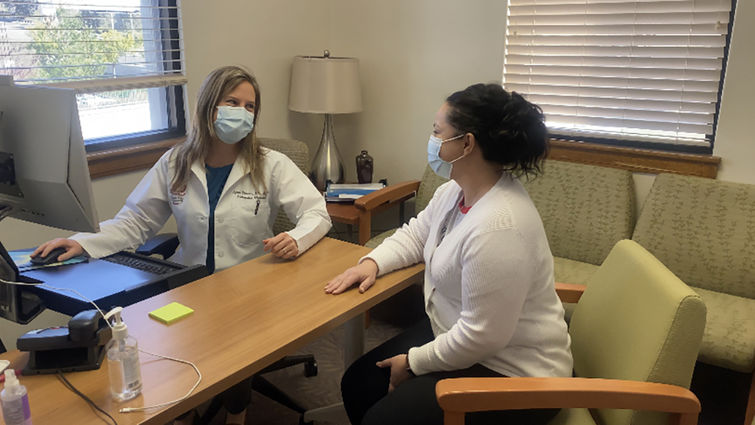
Dr. Wilson and patient
“Eat your veggies.” “Start taking walks.”
Why are these phrases expected when visiting your primary care provider? These recommendations support two of the six pillars of lifestyle medicine. Loma Linda University Health lifestyle and preventive medicine specialist April Wilson, MD, MPH, FACPM, outlines the importance of the six pillars and if all are optimized, can support your health by 80%.
“For most people, if the lifestyle factors are optimized, genetics will have a much more difficult time taking over,” Wilson says.
The health of a patient is driven by the individual’s willingness to change and the current behaviors practiced. When patients come in looking to make a change, the first two pillars typically addressed are nutrition and physical activity.
Nutrition
Whole foods and plant-based diets consist of unprocessed or minimally processed foods, including vegetables, fruit, beans, lentils, whole grains, nuts, and seeds. Nutrient-dense foods rich in fiber can contain anti-inflammatory and health protective properties, reducing inflammation and cholesterol, slowing the progression of metabolic and cardiovascular disease.
Physical Activity
Any amount of movement or exercise is better than being sedentary. Physicians will account for their patient’s health status and functional capacity before prescribing exercise regimens. Generally, guidelines for adults 18 to 64 years old recommend at least 150 minutes of moderate-intensity exercise weekly or 75 minutes of vigorous activity and two days of strength training. As outlined in this study, these standards can lower the risk of death of hypertension, COPD, diabetes, and much more. Physical Activity Guidelines for Americans outline multiple demographic guidelines.
Sleep
Physical activity can influence the quality of sleep. Adults should sleep at least seven hours per night regularly. Not achieving adequate sleep duration is associated with negative health outcomes such as heart disease, stroke, depression, and overall impaired immune function.
Stress Management
This pillar encompasses and is influenced by all other pillars of lifestyle medicine. Ways to manage stress include proper rest, nutrition, and other mindful habits outlined here.
During periods of high stress, the brain and body undergo chemical and physical changes. The chemicals released contribute to rapid heart rate, high blood pressure, and a weakened immune system. If left unmanaged, more serious health issues may arise, such as stroke, heart disease, and asthma.
Healthy Relationships
The people around you are more than your support system on your wellness journey. Evidence shows positive social connection significantly reduces the risk of premature mortality, indicating a 50% increased likelihood of survival in individuals with healthy relationships. Poor social connection or isolation increases the risk of poorer cognitive function and dementia.
Avoiding Unhealthy Habits
Unhealthy habits include substance use, gambling, and Wilson also includes screen time addictions. A substance use disorder doubles the odds for chronic diseases like arthritis, chronic pain, heart disease, stroke, hypertension, diabetes, and asthma.
“These habits impact mental and physical health because they encourage other unhealthy habits,” Wilson says. “Ultimately the individual does not feel at peace.”
Slowly implementing and tailoring the above six pillars to your life can drastically improve your odds against chronic disease. To make an appointment with a Loma Linda University Health lifestyle medicine provider, click here.
